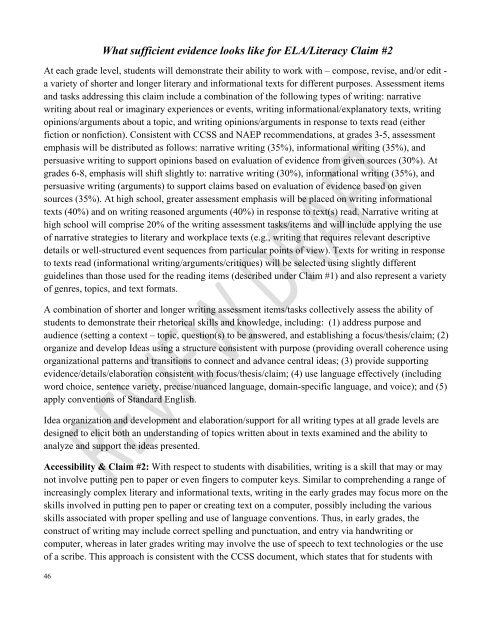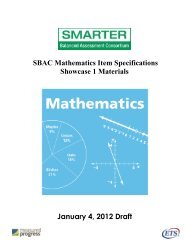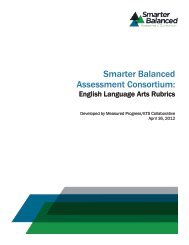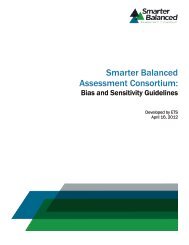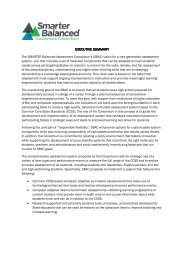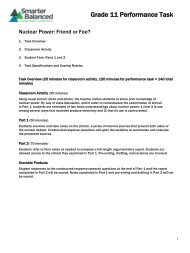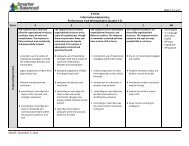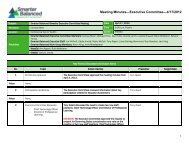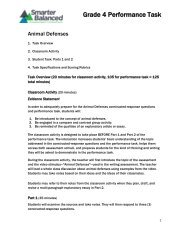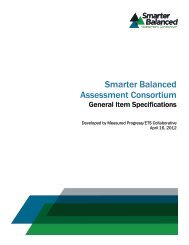Content Specifications for the Summative Assessment of the ...
Content Specifications for the Summative Assessment of the ...
Content Specifications for the Summative Assessment of the ...
Create successful ePaper yourself
Turn your PDF publications into a flip-book with our unique Google optimized e-Paper software.
46<br />
What sufficient evidence looks like <strong>for</strong> ELA/Literacy Claim #2<br />
At each grade level, students will demonstrate <strong>the</strong>ir ability to work with – compose, revise, and/or edit -<br />
a variety <strong>of</strong> shorter and longer literary and in<strong>for</strong>mational texts <strong>for</strong> different purposes. <strong>Assessment</strong> items<br />
and tasks addressing this claim include a combination <strong>of</strong> <strong>the</strong> following types <strong>of</strong> writing: narrative<br />
writing about real or imaginary experiences or events, writing in<strong>for</strong>mational/explanatory texts, writing<br />
opinions/arguments about a topic, and writing opinions/arguments in response to texts read (ei<strong>the</strong>r<br />
fiction or nonfiction). Consistent with CCSS and NAEP recommendations, at grades 3-5, assessment<br />
emphasis will be distributed as follows: narrative writing (35%), in<strong>for</strong>mational writing (35%), and<br />
persuasive writing to support opinions based on evaluation <strong>of</strong> evidence from given sources (30%). At<br />
grades 6-8, emphasis will shift slightly to: narrative writing (30%), in<strong>for</strong>mational writing (35%), and<br />
persuasive writing (arguments) to support claims based on evaluation <strong>of</strong> evidence based on given<br />
sources (35%). At high school, greater assessment emphasis will be placed on writing in<strong>for</strong>mational<br />
texts (40%) and on writing reasoned arguments (40%) in response to text(s) read. Narrative writing at<br />
high school will comprise 20% <strong>of</strong> <strong>the</strong> writing assessment tasks/items and will include applying <strong>the</strong> use<br />
<strong>of</strong> narrative strategies to literary and workplace texts (e.g., writing that requires relevant descriptive<br />
details or well-structured event sequences from particular points <strong>of</strong> view). Texts <strong>for</strong> writing in response<br />
to texts read (in<strong>for</strong>mational writing/arguments/critiques) will be selected using slightly different<br />
guidelines than those used <strong>for</strong> <strong>the</strong> reading items (described under Claim #1) and also represent a variety<br />
<strong>of</strong> genres, topics, and text <strong>for</strong>mats.<br />
A combination <strong>of</strong> shorter and longer writing assessment items/tasks collectively assess <strong>the</strong> ability <strong>of</strong><br />
students to demonstrate <strong>the</strong>ir rhetorical skills and knowledge, including: (1) address purpose and<br />
audience (setting a context – topic, question(s) to be answered, and establishing a focus/<strong>the</strong>sis/claim; (2)<br />
organize and develop Ideas using a structure consistent with purpose (providing overall coherence using<br />
organizational patterns and transitions to connect and advance central ideas; (3) provide supporting<br />
evidence/details/elaboration consistent with focus/<strong>the</strong>sis/claim; (4) use language effectively (including<br />
word choice, sentence variety, precise/nuanced language, domain-specific language, and voice); and (5)<br />
apply conventions <strong>of</strong> Standard English.<br />
Idea organization and development and elaboration/support <strong>for</strong> all writing types at all grade levels are<br />
designed to elicit both an understanding <strong>of</strong> topics written about in texts examined and <strong>the</strong> ability to<br />
analyze and support <strong>the</strong> ideas presented.<br />
Accessibility & Claim #2: With respect to students with disabilities, writing is a skill that may or may<br />
not involve putting pen to paper or even fingers to computer keys. Similar to comprehending a range <strong>of</strong><br />
increasingly complex literary and in<strong>for</strong>mational texts, writing in <strong>the</strong> early grades may focus more on <strong>the</strong><br />
skills involved in putting pen to paper or creating text on a computer, possibly including <strong>the</strong> various<br />
skills associated with proper spelling and use <strong>of</strong> language conventions. Thus, in early grades, <strong>the</strong><br />
construct <strong>of</strong> writing may include correct spelling and punctuation, and entry via handwriting or<br />
computer, whereas in later grades writing may involve <strong>the</strong> use <strong>of</strong> speech to text technologies or <strong>the</strong> use<br />
<strong>of</strong> a scribe. This approach is consistent with <strong>the</strong> CCSS document, which states that <strong>for</strong> students with


